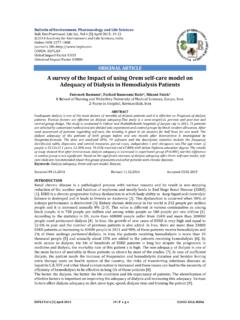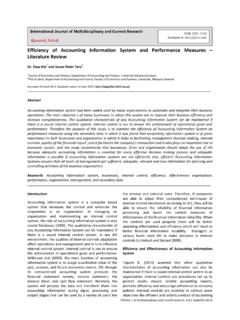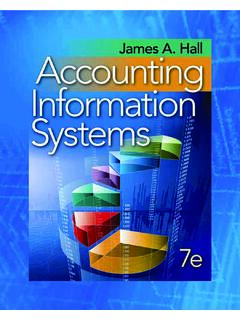Transcription of The Role of Accountants in Relation to Accounting ...
1 BEPLS Vol 4 [11] October 2015 115 | P a g e 2015 AELS, INDIA Bulletin of Environment, Pharmacology and Life Sciences Bull. Env. Pharmacol. Life Sci., Vol 4 [11] October 2015: 115-123 2015 Academy for Environment and Life Sciences, India Online ISSN 2277-1808 Journal s URL: CODEN: BEPLAD Global Impact Factor Universal Impact Factor ORIGINAL ARTICLE OPEN ACCESS The Role of Accountants in Relation to Accounting information Systems and Difference between Users of AIS and Users of Accounting Hadi Saeidi, Bhavani Prasad 2 Hamid Saremi 3 1- Accounting Department, Quchan Branch, Islamic Azad University, Quchan, Iran Email: 2-Professor of Business Management, Kakatiya University, Warangal, India Email: 3- Accounting Department, Quchan Branch, Islamic Azad University, Quchan, Iran Email.
2 ABSTRACT This study has aimed to identify the role of the Accountants in the Accounting information system and difference between users of AIS and users of Accounting . The role of the accountant in a business environment has been evolving over the years. Besides traditional Accounting knowledge, Accountants need to possess other skills that are vital to their survival in an effective organization. Accountants are primarily involved in three ways: as system users, designers, and auditors. Accounting information system (AIS) is that subsystem of overall management information system that provides information to an organization in the right format, size, time frame, and within a budget. Accountants have many roles to play as far as Accounting information system is concerned.
3 In this article, you will learn the various roles that Accountants play as regards Accounting information system . Keyword: system users, designers, auditors, Accounting information system Received Revised Accepted INTRODUCTION We begin the study of AIS with the recognition that information is a business resource. Like the other business resources of raw materials, capital, and labor, information is vital to the survival of the contemporary business organization. Every business day, vast quantities of information flow to decision makers and other users to meet a variety of internal needs. (7) Accounting information systems (AIS) as a part of company s information systems (IS) are seen as facilitating decision making within organizations and should be tailored to an organization s environment, requirements of task, and structure.
4 This consideration makes systems fit to task characteristics and organizational structure. Accounting information system (AIS) is vital to all organizations (2) and perhaps, each organization either profit or non profit-oriented need to maintain the AISs (10). On the other hand, an AIS is the whole of the related components that are put together to collect information , raw data or ordinary data and transform them into financial data for the purpose of reporting them to decision makers (6). To better understand the term Accounting information system , the three words constitute AIS would be elaborated separately. Firstly, literature documented that Accounting could be identified into three components, namely information system , language of business and source of financial information (9).
5 Secondly, information is a valuable data processing that provides a basis for making decisions, taking action and fulfilling legal obligation. Finally, system is an integrated entity, where the framework is focused on a set of objectives (4, 8). Therefore, Accountants in AIS summarize the results of a firm s transactions and issue reports to help managers make informed decisions. The role of accountant has expanded due to the development of the Accounting information of various business sectors, on the one hand, and the increase of the volume and the complexity of the information , on the other hand; the accountant shall play an active and effective role in the processes of designing the systems in order to achieve an effective internal system as well as the BEPLS Vol 4 [11] October 2015 116 | P a g e 2015 AELS, INDIA needs of Accounting information users (1).
6 There is no doubt the success of developing the system requires the necessity of participation of Accountants in establishing and developing that system . The effective method of applying the participation principle is represented by the ability of system to involve the Accountants not only in one stage of the development of the system but all stages of system development , in particular that each stage has its own specificity which distinguishes it from other stages; the real participation requires that the accountant shall interact mentally and emotionally through an intellectual debate and consultation with the persons who are responsible for developing the Accounting information system in a manner that encourages them to participate in bearing the responsibility and contributing to achieve the goals desired.
7 (3) COMPONENTS OF Accounting information SYSTEMS Accounting information systems generally consist of six main parts: Figure 1: Components of Accounting information system 1- People The people in AIS are simply the system users. Professionals who may need to use an organization's AIS include Accountants , consultants, business analysts, managers, chief financial officers and auditors. AIS help the different departments within a company work together. For example, management can establish sales goals for which staff can then order the appropriate amount of inventory. The inventory order notifies the Accounting department of a new payable. When sales are made, sales people can enter customer orders, Accounting can invoice customers, the warehouse can assemble the order, the shipping department can send it off, and the Accounting department gets notified of a new receivable.
8 The customer service department can then track customer shipments and the system can create sales reports for management. Managers can also see inventory costs, shipping costs, manufacturing costs and so on. 2- Procedure and Instructions The procedure and instructions of AIS are the methods it uses for collecting, storing, retrieving and processing data. These methods will be both manual and automated, and the data can come from both internal sources ( , employees) and external sources ( , customers' online orders). Procedures and instructions will be coded into AIS software; they should also be "coded" into employees through documentation and training. Procedures and instructions must be followed consistently to be effective. To store information , AIS must have a database structure such as structured query language (SQL), a computer language commonly used for databases.
9 The AIS will also need various input screens for the different types of system users and different types of data entry, as well as different output formats to meet the needs of different users and different types of information . 3- Data The data contained in AIS is all the financial information pertinent to the organization's business practices. Any business data that impacts the company's finances should go into AIS. The data included in AIS will depend on the nature of the business, but it may consist of the following: Saeidi et al BEPLS Vol 4 [11] October 2015 117 | P a g e 2015 AELS, INDIA sales orders customer billing statements sales analysis reports purchase requisitions vendor invoices check registers general ledger inventory data payroll information timekeeping tax information This data can then be used to prepare Accounting statements and reports such as accounts receivable aging, depreciation/amortization schedules, trial balance, profit and loss, and so on.
10 Having all this data in one place - in the AIS - facilitates a business's recordkeeping, reporting, analysis, auditing and decision-making activities. For the data to be useful, it must be complete, correct and relevant. On the other hand, examples of data that would not go into AIS include memos, correspondence, presentations and manuals. These documents might have a tangential relationship to the company's finances, but excluding the standard footnotes, they are not really part of the company's financial recordkeeping. 4- Software The software component of AIS is the computer programs used to store retrieve process and analyze the company's financial data. Before there were computers, AISs were manual, paper-based systems, but today, most companies are using computer software as the basis of the AIS.














